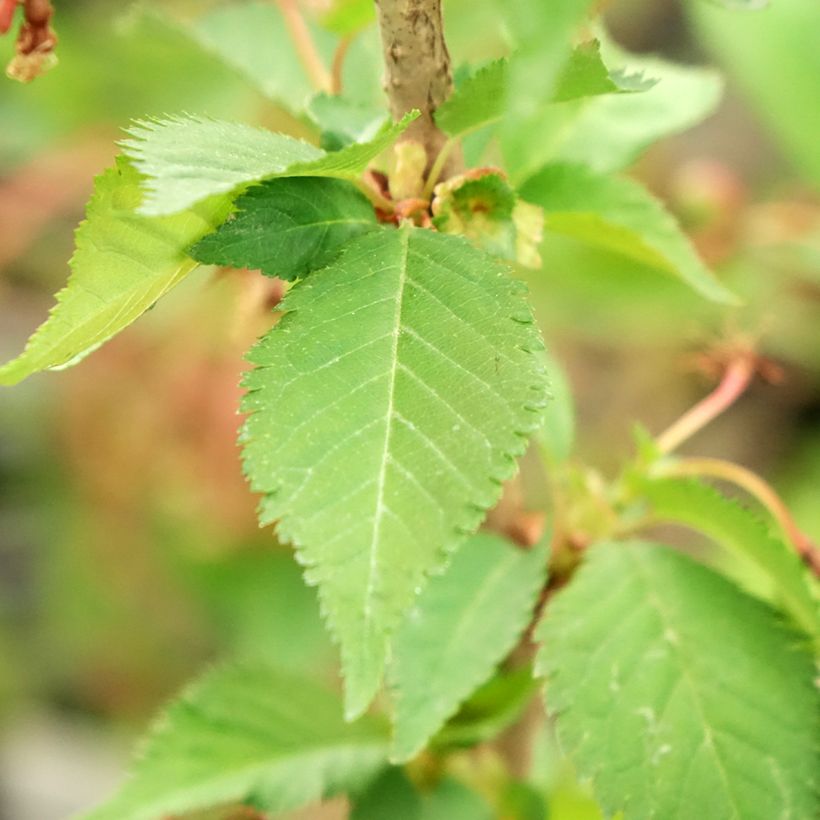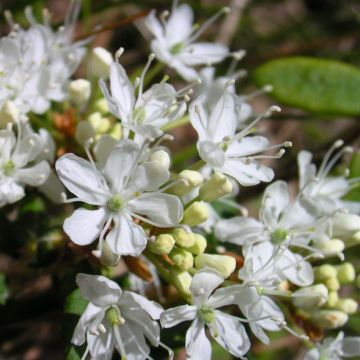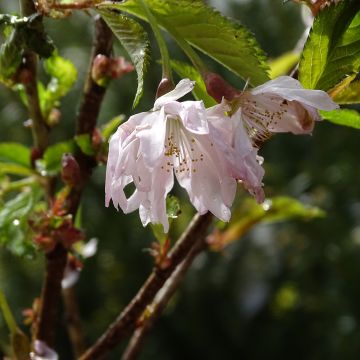

Prunus nipponica var. kurilensis Brillant - Kuril Cherry


Prunus nipponica var. kurilensis Brillant - Kuril Cherry


Prunus nipponica var. kurilensis Brillant - Kuril Cherry
Prunus nipponica var. kurilensis Brillant - Kuril Cherry
Prunus nipponica var. kurilensis Brillant
Kuril Cherry, Kurile Island Cherry
My first Prunus... I've been dreaming of it for a long time. The young plant received is of a good size, in perfect condition and seems healthy. I can't wait to see it in flower and leaf.
Laetitia, 13/03/2023
Special offer!
Receive a €20 voucher for any order over €90 (excluding delivery costs, credit notes, and plastic-free options)!
1- Add your favorite plants to your cart.
2- Once you have reached €90, confirm your order (you can even choose the delivery date!).
3- As soon as your order is shipped, you will receive an email containing your voucher code, valid for 3 months (90 days).
Your voucher is unique and can only be used once, for any order with a minimum value of €20, excluding delivery costs.
Can be combined with other current offers, non-divisible and non-refundable.
Home or relay delivery (depending on size and destination)
Schedule delivery date,
and select date in basket
This plant carries a 24 months recovery warranty
More information
We guarantee the quality of our plants for a full growing cycle, and will replace at our expense any plant that fails to recover under normal climatic and planting conditions.

Would this plant suit my garden?
Set up your Plantfit profile →
Description
Prunus nipponica var. kurilensis Brilliant, is a small flowering cherry tree from Japan with an upright habit and dense vegetation that can be planted to admire its fabulous flowering from the window, which signals the end of winter, but also for its brilliant autumn foliage. Its countless small single flowers, ranging from very pale pink to deep pink at the centre, bloom before the appearance of the foliage and produce small edible ornamental cherries. A beautiful slow-growing and modest-sized flowering shrub, it has a place in all gardens, even the smallest ones. Give it a sunny exposure and ordinary soil that is not too chalky or too dry.
Prunus kurilensis (synonyms Cerasus kurilensis, Prunus nipponica f. kurilensis), from the large family of Rosaceae, is a very hardy species (down to -25 °C (-13 °F)) endemic to the Kuril Islands, located in the far north of Japan, as well as the island of Sakhalin.
The 'Brilliant' cultivar, with a slow but regular growth, has a bushy, dense, and upright habit, supported by thick, sturdy, and erect branches. Its crown widens over time. At maturity, around the age of 20, it will not exceed 3 m (9 ft 10 in) in height, reaching about 2 m (6 ft 7 in) in spread at the top of the crown. In February or March depending on the region, often before the appearance of the foliage, numerous pale pink flower buds appear on the previous year's branches, which open into small flowers with five white-pink petals, a bright pink centre, and yellow stamens. Slightly fragrant and nectar-rich, they are visited by bees. The corolla is enclosed in a darker pink calyx, giving the overall flowering a very pale pink colour. The flowers give way to small fruits called drupes, highly sought after by birds. The deciduous foliage is composed of entire, alternate, lanceolate leaves, 4 to 7 cm (1.6 to 2.8 in) long, finely toothed along the edges. They are shiny and tinted bronze-copper in spring, medium green in summer, and then turn orange and red in autumn.
Slow-growing, of modest stature, and requiring very little maintenance, this small tree, easy to keep short through pruning, is perfectly suited to small gardens, where it will be particularly highlighted as a standalone specimen or in the centre of a perennial bed whose flowering will take over from spring to summer. It can also be planted in a border or as a free hedge. The perfectly hardy Prunus 'Brilliant' can be grown in many regions but dislikes compact, chalky and/or very clayey soils or, on the contrary, excessively dry situations. For example, it can be associated with other spring-flowering shrubs, either simultaneous or staggered, such as forsythias, Japanese quinces, Honeysuckle (Lonicera xylosteum), ornamental apple trees , flowering peaches, double-flowered almond trees, or hawthorns, etc.
Prunus nipponica var. kurilensis Brillant - Kuril Cherry in pictures




Plant habit
Flowering
Foliage
Botanical data
Prunus
nipponica var. kurilensis
Brillant
Rosaceae
Kuril Cherry, Kurile Island Cherry
Cultivar or hybrid
Other Prunus
View all →Planting and care
Prunus nipponica Brillant thrives in full sun in a balanced, moist but well-drained soil that is not too compact and wet, nor too dry, nor too acidic, nor too chalky. Water during abnormally dry and hot weather. When planting, mix your soil with compost at a ratio of 50%. Dig a large planting hole. Apply a flowering shrub fertiliser every spring. Beware of late frosts that could damage early flowering. It is therefore preferable to place the prunus in a somewhat sheltered location from dry and cold winds.
Planting period
Intended location
Care
Planting & care advice
-
, onOrder confirmed
Reply from on Promesse de fleurs
Similar products
Haven't found what you were looking for?
Hardiness is the lowest winter temperature a plant can endure without suffering serious damage or even dying. However, hardiness is affected by location (a sheltered area, such as a patio), protection (winter cover) and soil type (hardiness is improved by well-drained soil).

Photo Sharing Terms & Conditions
In order to encourage gardeners to interact and share their experiences, Promesse de fleurs offers various media enabling content to be uploaded onto its Site - in particular via the ‘Photo sharing’ module.
The User agrees to refrain from:
- Posting any content that is illegal, prejudicial, insulting, racist, inciteful to hatred, revisionist, contrary to public decency, that infringes on privacy or on the privacy rights of third parties, in particular the publicity rights of persons and goods, intellectual property rights, or the right to privacy.
- Submitting content on behalf of a third party;
- Impersonate the identity of a third party and/or publish any personal information about a third party;
In general, the User undertakes to refrain from any unethical behaviour.
All Content (in particular text, comments, files, images, photos, videos, creative works, etc.), which may be subject to property or intellectual property rights, image or other private rights, shall remain the property of the User, subject to the limited rights granted by the terms of the licence granted by Promesse de fleurs as stated below. Users are at liberty to publish or not to publish such Content on the Site, notably via the ‘Photo Sharing’ facility, and accept that this Content shall be made public and freely accessible, notably on the Internet.
Users further acknowledge, undertake to have ,and guarantee that they hold all necessary rights and permissions to publish such material on the Site, in particular with regard to the legislation in force pertaining to any privacy, property, intellectual property, image, or contractual rights, or rights of any other nature. By publishing such Content on the Site, Users acknowledge accepting full liability as publishers of the Content within the meaning of the law, and grant Promesse de fleurs, free of charge, an inclusive, worldwide licence for the said Content for the entire duration of its publication, including all reproduction, representation, up/downloading, displaying, performing, transmission, and storage rights.
Users also grant permission for their name to be linked to the Content and accept that this link may not always be made available.
By engaging in posting material, Users consent to their Content becoming automatically accessible on the Internet, in particular on other sites and/or blogs and/or web pages of the Promesse de fleurs site, including in particular social pages and the Promesse de fleurs catalogue.
Users may secure the removal of entrusted content free of charge by issuing a simple request via our contact form.
The flowering period indicated on our website applies to countries and regions located in USDA zone 8 (France, the United Kingdom, Ireland, the Netherlands, etc.)
It will vary according to where you live:
- In zones 9 to 10 (Italy, Spain, Greece, etc.), flowering will occur about 2 to 4 weeks earlier.
- In zones 6 to 7 (Germany, Poland, Slovenia, and lower mountainous regions), flowering will be delayed by 2 to 3 weeks.
- In zone 5 (Central Europe, Scandinavia), blooming will be delayed by 3 to 5 weeks.
In temperate climates, pruning of spring-flowering shrubs (forsythia, spireas, etc.) should be done just after flowering.
Pruning of summer-flowering shrubs (Indian Lilac, Perovskia, etc.) can be done in winter or spring.
In cold regions as well as with frost-sensitive plants, avoid pruning too early when severe frosts may still occur.
The planting period indicated on our website applies to countries and regions located in USDA zone 8 (France, United Kingdom, Ireland, Netherlands).
It will vary according to where you live:
- In Mediterranean zones (Marseille, Madrid, Milan, etc.), autumn and winter are the best planting periods.
- In continental zones (Strasbourg, Munich, Vienna, etc.), delay planting by 2 to 3 weeks in spring and bring it forward by 2 to 4 weeks in autumn.
- In mountainous regions (the Alps, Pyrenees, Carpathians, etc.), it is best to plant in late spring (May-June) or late summer (August-September).
The harvesting period indicated on our website applies to countries and regions in USDA zone 8 (France, England, Ireland, the Netherlands).
In colder areas (Scandinavia, Poland, Austria...) fruit and vegetable harvests are likely to be delayed by 3-4 weeks.
In warmer areas (Italy, Spain, Greece, etc.), harvesting will probably take place earlier, depending on weather conditions.
The sowing periods indicated on our website apply to countries and regions within USDA Zone 8 (France, UK, Ireland, Netherlands).
In colder areas (Scandinavia, Poland, Austria...), delay any outdoor sowing by 3-4 weeks, or sow under glass.
In warmer climes (Italy, Spain, Greece, etc.), bring outdoor sowing forward by a few weeks.



























































